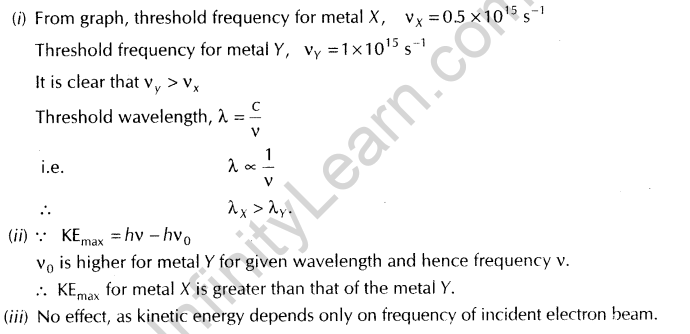Table of Contents
Get a free PDF download of important questions with answers for CBSE Class 12 Physics Chapter 11 – Dual Nature of Radiation and Matter, prepared by expert Physics teachers from the latest edition of CBSE (NCERT) books. Register online for Physics on Infinitylearn.com to score higher marks in the CBSE board examination.
Download CBSE Class 12 Physics Important Questions 2023-24 PDF
Students can check CBSE Class 12 Physics Important Questions for other chapters:
| CBSE Class 12 Physics Important Questions | ||
| S.No | Chapter No | Chapter Name |
| 1 | Chapter 1 | Electric Charges and Fields |
| 2 | Chapter 2 | Electrostatic Potential and Capacitance |
| 3 | Chapter 3 | Current Electricity |
| 4 | Chapter 4 | Moving Charges and Magnetism |
| 5 | Chapter 5 | Magnetism And Matter |
| 6 | Chapter 6 | Electromagnetic Induction |
| 7 | Chapter 7 | Alternating Current |
| 8 | Chapter 8 | Electromagnetic Waves |
| 9 | Chapter 9 | Ray Optics and Optical Instruments |
| 10 | Chapter 10 | Wave Optics |
| 11 | Chapter 11 | Dual Nature of Radiation and Matter |
| 12 | Chapter 12 | Atoms |
| 13 | Chapter 13 | Nuclei |
| 14 | Chapter 14 | Semiconductor Electronic: Material, Devices And Simple Circuits |
| 15 | Chapter 15 | Communication System |
Dual Nature of Radiation and Matter Important Questions for CBSE Class 12 Physics Photoelectric Effect
1. Photoelectric Effect- The phenomenon of emission of photoelectron from the surface of metal, when a light beam of suitable frequency is incident on it, is called photoelectric effect. The emitted electrons are called photoelectrons and the current so produced is called photoelectric current.
Hertz’ Observation – The phenomenon of photo electric emission was discovered in 1887 by Heinrich Hertz during his electromagnetic wave experiment. In his experimental investigation on the production of electromagnetic waves by means of spark across the detector loop were enhanced when the emitter plate was illuminated by ultraviolet light
from an arc lamp.
Lenard’s Observation – Lenard observed that when ultraviolet radiation were allowed to fall on emitter plate of an evacuated glass tube enclosing two electrodes, current flows. As soon as, the ultraviolet radiations were stopped, the current flows also stopped. These observations indicate that when ultraviolet radiations fall on the emitter plate, electrons are ejected from it which are attracted towards the positive plate by the electric field.
2.Terms Related to Photoelectric Effects
There are many terms related to photoelectric effects which are of follow:
- Free Electrons In metals, the electrons in the outer shells (valence electrons) are loosely bound to the atoms, hence they are free to move easily within the metal surface but cannot leave the metal surface. Such electrons are called free electrons.
- Electron Emission The phenomenon of emission of electrons from the surface of a metal is called electron emission.
- Photoelectric Emission It is the phenomenon of emission of electrons from the surface of metal when light radiations of suitable frequency fall on it.
- Work Function The minimum amount of energy required to just eject an electron from the outer most surface of metal is known as work function of the metal.

- Cut-off Potential For a particular frequency of incident radiation, the minimum negative (retarding) potential V0 given to plate for which the photoelectric current becomes zero, is called cut-off or stopping potential.

- Cut-off Frequency The minimum frequency of light which can emit photoelectrons from a material is called threshold frequency or cut-off frequency of that material
- Cut-off Wavelength The maximum wavelength of light which can emit photoelectrons from a material is called threshold wavelength or cut-off wavelength of that material.
Click Here: CBSE Class 12 Physics Syllabus 2024
3. Effect of Intensity of Light on Photocurrent – For a fixed frequency of incident radiation, the photoelectric current increases linearly with increase in intensity of incident light.
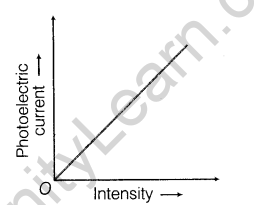
4. Effect of Potential on Photoelectric Current – For a fixed frequency and intensity of incident light, the photoelectric current increases with increase in the potential applied to the collector. When all the photoelectrons reach the plate A, current becomes maximum it is known as saturation current.
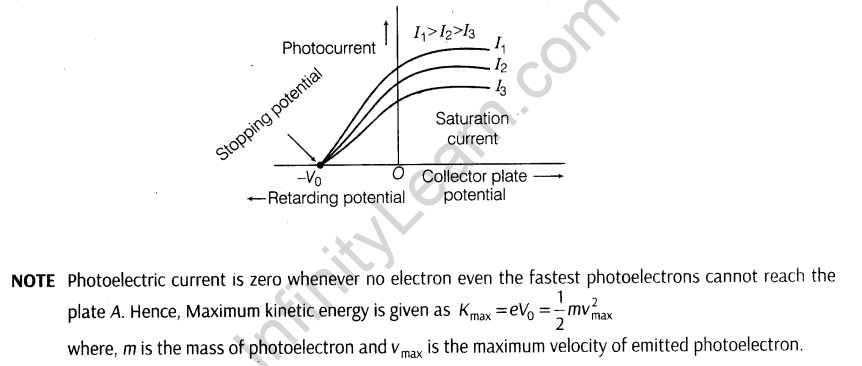
5. Effect of Frequency of Incident Radiation on Stopping Potential – We take radiations of different frequencies but of same intensity. For each radiation, we study the variation of photoelectric current against the potential difference between the plates.
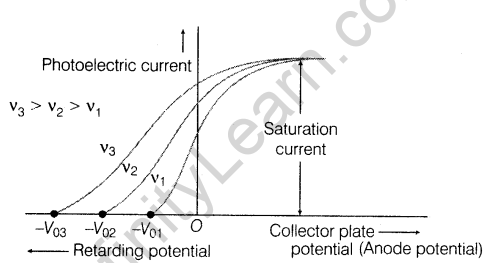
6. Laws of Photoelectric Emission
- For a given material and a given frequency of incident radiation, the photoelectric current number of photoelectrons ejected per second is directly proportional to the intensity of the incident light.
- For a given material and frequency of incident radiation, saturation current is found to be proportional to the intensity of incident radiation, whereas the stopping potential is independent of its intensity.
- For a given material, there exists a certain minimum frequency of the incident radiation below which no emissions of photoelectrons takes place. This frequency is called threshold frequency.
Above the threshold frequency, the maximum kinetic energy of the emitted photoelectron or equivalent stopping potential is independent of intensity of incident light but depends only upon the frequency (or wavelength) of the incident light.
- The photoelectric emission is an instantaneous process. The time lag between the incidence of radiations and emission of photoelectron is very small, less than even 10 –9
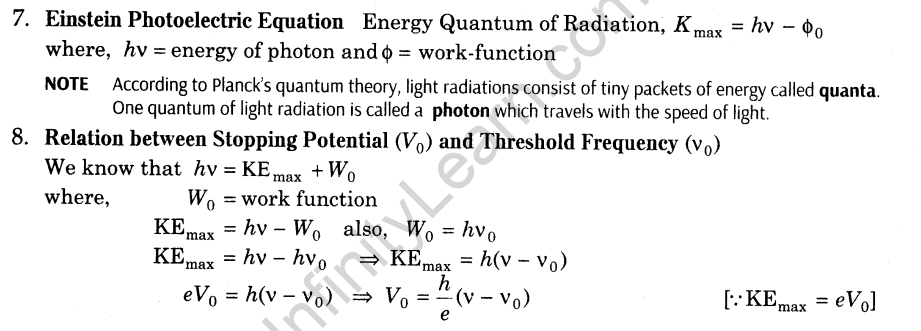
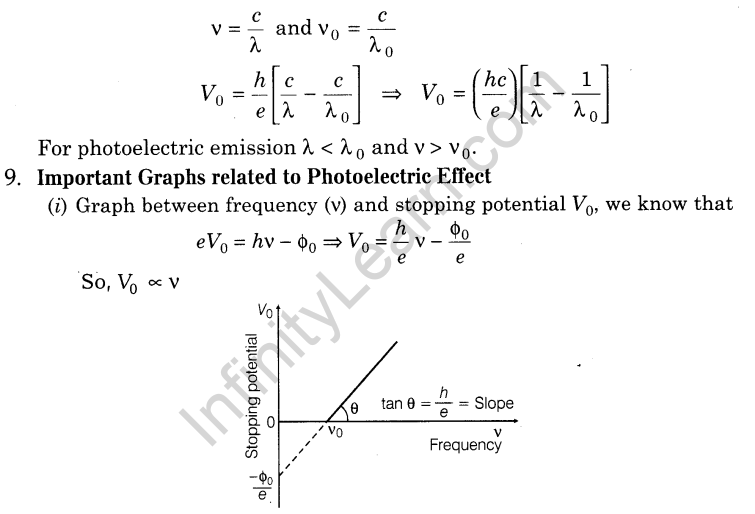
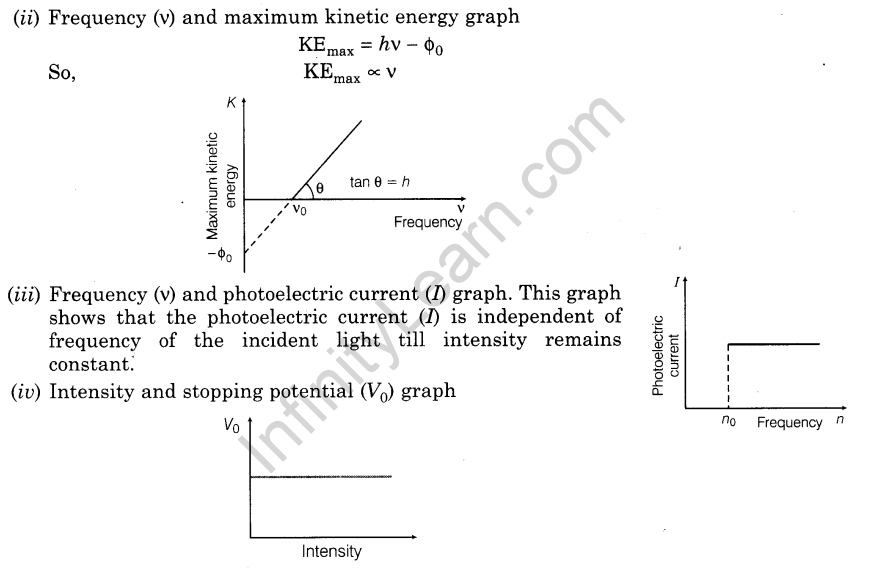
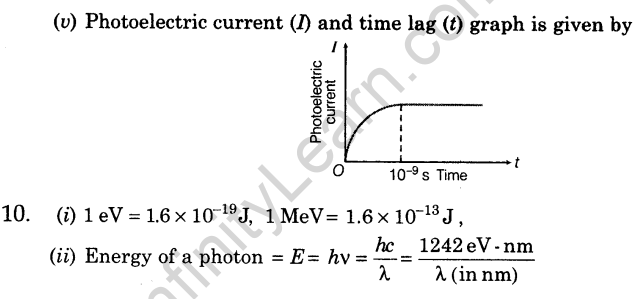
Also Check: CBSE Class 12 Physics Answer Key 2024 | CBSE CBSE Class 12 Physics Paper Analysis 2024
Previous Years’ Examination Questions
1 Mark Questions
1. Define intensity of radiation on the basis of photon picture of light. Write its SI unit. [All India 2014]
Ans. The intensity of radiation is defined as the rate of emitted energy from unit surface area through unit solid angle.
Its SI unit is W/m2 sr- 1.
2.The graph shows the variation of stopping potential with frequency of incident radiation for two photosensitive metals A and B. Which one of the two has higher value of work-function? Justify your answer. [All India 2014]
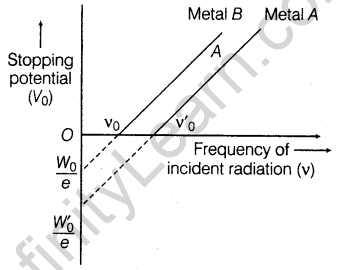
Ans. Metal A has higher value of work- function because and the intercept of the line of the given graph depends on work-function.
3. The graph shows variation of stopping potential V0 versus frequency of incident radiation v for two photosensitive metals A and Which one of the two metals has higher threshold frequency and why? [All India 2014]
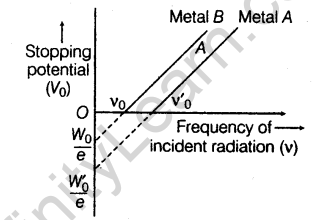
Ans.
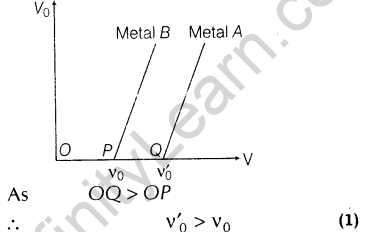
So, the threshold frequency of metal A is greater than metal B.
4. In photoelectric effect, why should the photoelectric current increase as the intensity of monochromatic radiation incident on a photosensitive surface is increased? Explain. [Foreign 2014]
Ans. Photoelectric effect is a one photon-one electron phenomenon. Therefore, when the intensity of radiation incident on the surface increases the number of photons per unit area unit time increases (since intensity of incident radiation number of photons).
Hence, the photo electrons ejected will be large, which in turn, will contribute to the increase in photoelectric current.
5. The given graph shows the variation of photoelectric current (I) versus applied voltage (V) for two different photosensitive materials and for two different intensities of the incident radiations. Identify the pairs of curves that corresponds to different materials but same intensity of incident radiation. [Delhi 2013]
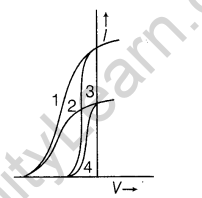
Ans. Curves 1 and 2 correspond to similar materials while curves 3 and 4 represent different materials, since the value of stopping potential for the pair of curves (1 and 2) and (3 and 4) are the same. For given frequency of the incident radiation, the stopping potential is independent of its intensity.
So, the pairs of curves (1 and 3) and (2 and 4) correspond to different materials but same intensity of incident radiation.
6. Show on a plot the nature of variation of photoelectric current with the intensity of radiation incident on a photosensitive surface. [Delhi 2013C]
Ans. Graph of variation of photoelectric current with the intensity of radiation incident on a photosensitive surface is given as below
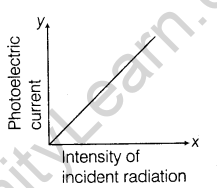
7. Define intensity of radiation in photon picture of light. [All India 2012]
Ans. The intensity of radiation is defined as the rate of emitted energy from unit surface area through unit solid angle. Its SI unit is W/m2 sr- 1.
8. Define the term stopping potential in relation to photoelectric effect. [All India 2011]
Ans. In experimental set up of photoelectric effect, the value of negative potential of anode at which photoelectric current in the circuit reduces to zero is called stopping potential or cut-off potential for the given frequency of the incident radiation.
9. Show the variation of photocurrent with collector plate potential for different frequencies but same intensity of incident radiation. [Foreign 2011, All India 2010 ]
Ans. The variation of photocurrent with collector plate potential for different plate frequencies is shown as below:

10. Show the variation of photocurrent with collector plate potential for different intensities but same frequency of incident radiation. [Foreign 2011, All India 2010; 2011 ]
Ans. The variation of photocurrent with collector plate potential for different intensities at constant frequency is shown as below
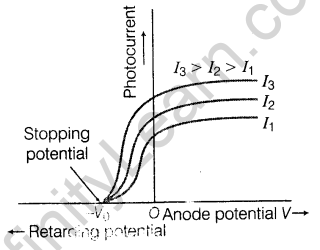
11.The stopping potential in an experiment on photoelectric effect is 1.5 V. What is the maximum kinetic energy of the photoelectrons emitted? [All India 2009, HOTS]
Ans.
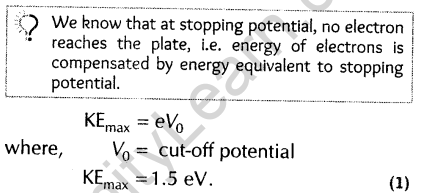
12. The maximum kinetic energy of a photoelectron is 3eV. What is its stopping potential? [All India 2009]
Ans
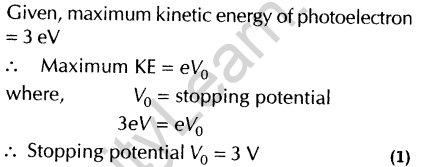
13. The stopping potential in an experiment on photoelectric effect is 2 V. What is the maximum kinetic energy of the photoelectrons emitted? [All India 2009]
Ans

14. The figure shows a plot of three curves a, b, c showing the variation of photocurrent vs collector plate potential for three different intensities I1, I2 and I3 having frequencies v1 v2 and v3, respectively incident on a photosensitive surface. Point out the two curves for which the incident radiations have same frequency but different intensities.
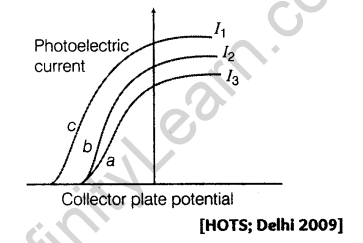
Ans. The photoelectric current is directly proportional to the intensity of incident radiation. Energy of photoelectrons or cut-off potential depends on frequency of incident radiation.Curves, a and b have got same cut-off potential, so for these two curves frequencies will be same.
2 Marks Questions
15. (i) Monochromatic light of frequency 6.0×1014 Hz is produced by a laser. The power emitted is 2.0 x 103 W. Estimate the number of photons emitted per second on an average by the source.
(ii) Draw a plot showing the variation of photoelectric current versus the intensity of incident radiation on a given photosensitive surface. [Delhi 2014]
Ans.
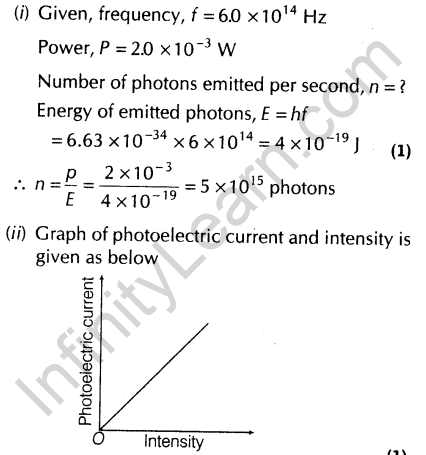
16. (i) Monochromatic light of frequency 5.0 x 1014 Hz is produced by laser. The power emitted is 3.0 x 10′3 W. Estimate the number of photons emitted per second on an average by the source.
(ii) Draw a plot showing the variation of photoelectric current versus the intensity of incident radiation on a given photosensitive surface. [Delhi 2014]
Ans. (i) 7.5 x1015 Refer to ans. 15 (i)
(ii) Refer to ans. 15 (ii).
17. Write three basic properties of photons which are used to obtain Einstein’s photoelectric equation. Use this equation to draw a plot of maximum kinetic energy of the electrons emitted versus frequency of incident radiation. [All India 2014]
Ans. Three basic properties of photons are given as below :
(i) Photons are quanta or discrete carriers of energy.
(ii) Energy of a photon is proportional to the frequency of light.
(iii) The photon gives all its energy to the electron with which it interacts.
Einstein’s photoelectric equation
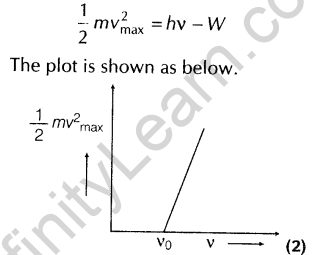
18. (i) Define the term stopping potential.
(ii) Plot a graph showing the variation of photoelectric current as a function of anode potential for two light beams of same intensity but of different frequencies v1 and v2(v2 > v1). [All India 2014 C]
Ans. In experimental set up of photoelectric effect, the value of negative potential of anode at which photoelectric current in the circuit reduces to zero is called stopping potential or cut-off potential for the given frequency of the incident radiation.
19. (i)Define the term threshold frequency as used in photoelectric effect.
(ii) Plot a graph showing the variation of photoelectric current as a function of anode potential for two light beams having the same frequency but different intensities and I2 > I2 )• [All India 2014 C]
Ans. For a given material, there exists a certain minimum frequency of the incident radiation below which no emission of photoelectrons take place. This frequency is called the threshold frequency.
20.Two monochromatic radiations of frequencies v2 and v2(v1 >v2) and having the same intensity are in turn, incident on a photosensitive surface to cause photoelectric emission. Explain giving reason in which case (i) more number of electrons will be emitted and (ii) maximum kinetic energy of the emitted photoelectrons will be more. [Delhi 2014C]
>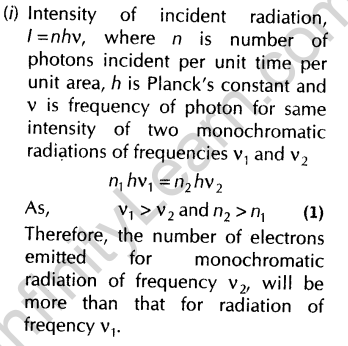
21. Name the phenomenon which shows the quantum nature of electromagnetic radiation. (Delhi 2014)
Ans. Photoelectric Effect
22.Write Einstein’s photoelectric equation. State clearly the three salient features observed in photoelectric effect which can be explained on the basis of above equation. [All India 2010]
Ans.
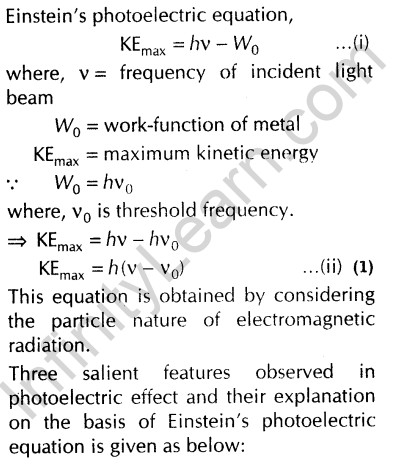
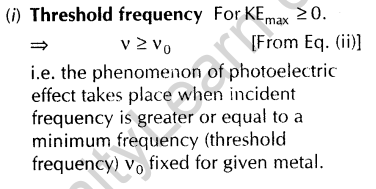
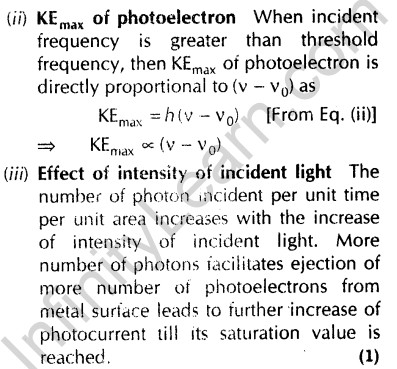
23. Plot a graph showing the variation of stopping potential with the frequency of incident radiation for two different photosensitive materials having work-functions and W2 (W1> W2). On what factors does the
- slope and
- intercept of the lines depend? [Delhi 2010]
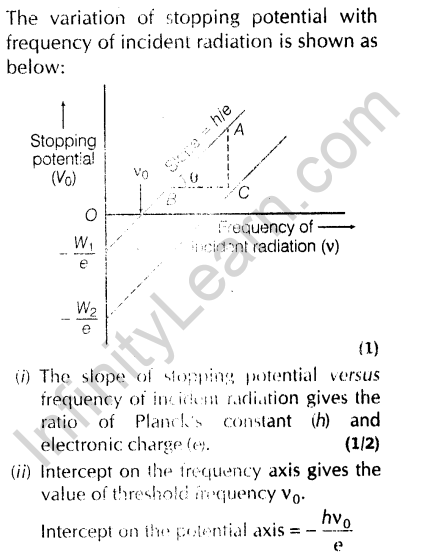
24. Figure shows variation of stopping potential (V0) with the frequency (v) for two photosensitive materials M1 and M2.
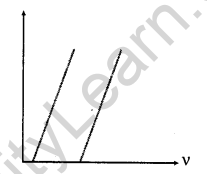
(i) Why is the slope same for both lines?
(ii) For which material will the emitted electrons have greater kinetic energy for the incident radiation of the same frequency? Justify your answer. [Foreign 2009]
Ans.
The slope of a straight line graph is equal to I the ratio of value on Y-axis to X-axis.
(i) Slope of stopping potential with frequency of incident radiation gives the value of Planck’s constant, i.e. the reason why the slope is same for both lines.
(ii) The intercept of graph on stopping potential gives the value of stopping potential which is higher for M2.
So, for the photoelectrons to be emitted from material M2, kinetic energy will also be higher.

25. The given graph shows variation of photoelectric current with collector plate potential for different frequencies of incident radiation.
(i) Which physical parameter is kept constant for the three curves?
(ii) Which frequency (v1 ,v2 or v3) is the highest? [Foreign 2009]
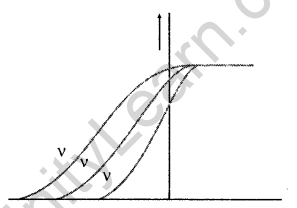
Ans. (i) According to laws of photoelectric emission, the photoelectric current depends on the intensity of incident light. The constant saturation value of photoelectric current reveals that intensity of incident light is constant.
(ii) Frequency Vt is the highest among v1 ,v2 and v3 because higher the cut-off potential, higher will be the frequency of incident light.
26. Plot a graph showing variation of stopping potential (V0) with the frequency (v) of the incident radiation for a given photosensitive material. Hence, state the significance of the threshold frequency in photoelectric emission. Using the principle of energy conservation, write the equation relating the energy of incident photon, threshold frequency and the maximum kinetic energy of the emitted photoelectrons [Delhi 2009c]
Ans.

From the equation, if v < v0 then (KE)max is negative, which is not possible. For a given material, there exists a certain minimum frequency of the incident radiation below which no emission of photoelectrons take place, this is called threshold frequency, i.e. photoelectric effect will take place only when v>v0.
27. Write Einstein’s photoelectric equation relating the maximum kinetic energy of the emitted electron to the frequency of the radiation incident on a photosensitive surface. State clearly the basic elementary process involved in photoelectric effect. [All India 2009C]
Ans.



28. Write Einstein’s photoelectric equation. Explain the terms:
- threshold frequency and
- stopping potential. [Delhi 2008C]
Ans. (i) For Einstein’s photoelectric equation and definition of threshold frequency Refer to ans. 22.
(ii) Stopping potential The minimum negative potential given to plate w.r.t. cathode, at which no photoelectron reaches the plate is called stopping potential. It is represented by V0.
29. Write Einstein’s photoelectric equation in terms of the stopping potential and the threshold frequency for a given photosensitive material. Draw a plot showing the variation of stopping potential versus the frequency of incident radiation. [All India 2008]

3 Marks Questions
30. (i) Why photoelectric effect cannot be explained on the basis of wave nature of light? Give reasons.
(ii) Write the basic features of photon picture of electromagnetic radiation on which Einstein’s photoelectric equation is based. [Delhi 2013]
Ans. (i) The photoelectric effect cannot be
explained on the basis of wave nature of light because wave nature of radiation cannot explain the following:
- The instantaneous ejection of photoelectrons.
- The existence of threshold frequency for a metal surface.
- The fact that kinetic energy of the emitted electrons is independent of the intensity of light and depends upon its frequency
(ii) Photon picture of electromagnetic radiation on which Einstein’s photoelectric equation is based on particle nature of light. Its basic features are given as below:
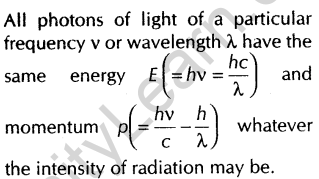
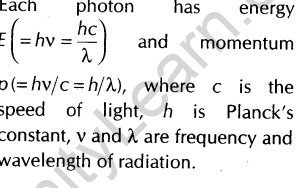
- In interaction of radiation with matter, radiation behaves as if it is made up of particles called photons.
- By increasing the intensity of light of given wavelength, there is only an increase in the number of photons per second crossing a given area with each photon having the same energy. Thus, photon energy is independent of intensity of radiation.
- Photons are electrically neutral and are not deflected by electric end magnetic fields.
- In a photon-particle collision (such as photon-electron collision), the total energy and total momentum are conserved. However, number of photons may not be conserved.
- The velocity of photon in different media is different which is due to the change in its wavelength.
31. Write Einstein’s photoelectric equation and point out any two characteristic properties of photons on which this equation is based. Briefly explain three observed features which can be explained by this equation. [All India 2013]
Ans. For Einstein equation Refer to ans. 22.
The two characteristic properties of photons on which this equation is based are as follows
(i) Photons have particle characteristics. It is emitted or absorbed in units called quanta of light.
(ii) Photons have wave characteristics. It travels in space with particular frequency, a characteristic of waves.
32. (i) State three important properties of photons which describe the particle picture of electromagnetic radiation.
(ii) Use Einstein’s photoelectric equation to define the terms :
- Stopping potential and
- Threshold frequency. [Delhi 2013C]
Ans. The three important properties of photon are given as below:
(a) photon is massless, has no electric charge and is stable.
(b) Photons are emitted in many natural processes.
(c) The photon also carries spin angular momentum that does not depend on its frequency.
(ii) Einsten‘s photoelectric equation is given by
eV0 =h (v – v0)
- Refer to ans. 28.
- Refer to ans. 19 (i). (1/2)
33. Write two characteristic features observed in photoelectric effect which supports the photon pictures of electromagnetic radiation. Draw a graph between the frequency of incident radiation (v) and the maximum kinetic energy of the electrons emitted from the surface of a photosensitive material. State clearly how this graph can be used to determine the
(i) Planck constant and (ii) work-function of the material? [Foreign 2012]
Ans.
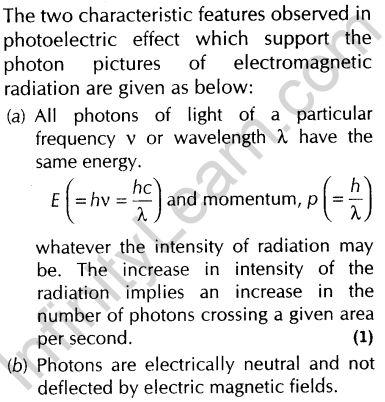
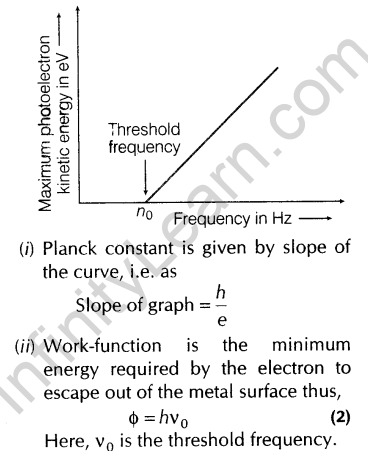
34. Write Einstein’s photoelectric equation. State clearly how this equation is obtained using the photon picture of electromagnetic radiation. Write the three salient features observed in photoelectric effect which can be explained using this equation. [Delhi 2012]
Ans.



35. Define the terms cut-off voltage and threshold frequency in relation to the phenomenon of photoelectric effect. Using Einstein’s photoelectric equation show how the cut-off voltage and threshold frequency for a given photosensitive material can be determined with the help of a suitable plot/graph. [All India 2012]
Ans.


36. Draw a plot showing the variation of photoelectric current with collector plate potential for two different frequencies, v2 >v1 of incident radiation having the same intensity. In which case will the stopping potential be higher? Justify your answer. [All India 2011]
Ans.
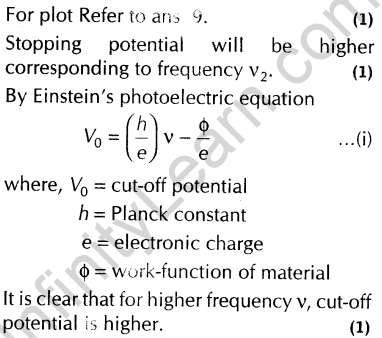
37. (i) Ultraviolet light of wavelength 2271 A from a 100 W mercury source is incident on a photocell made of molybdenum metal. If the stopping potential is 13 V, estimate the work-function of the metal.
(ii) How would the photocell respond to high intensity? (105W/m2) red light of wavelength 6328 A produced by a He-Ne laser? [Delhi 2011C]
Ans.
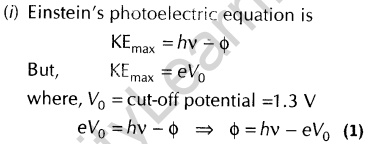
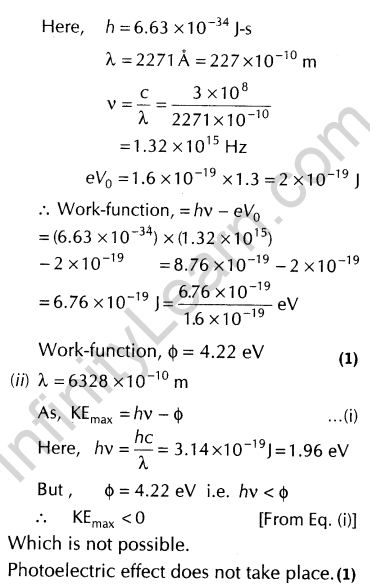
38. Define the terms threshold frequency and stopping potential in the study of photoelectric emission. Explain briefly the reasons why wave theory of light is not able to explain the observed features in photoelectric effect? [Foreign 2010]
Ans. Threshold frequency The minimum frequency below which there is no occurrence of photoelectric effect is called the cut-off frequency or threshold frequency and denoted by v0.
Stopping potential Refer to ans. 18 (ii). The wave theory of light is not able to explain the observed features of photoelectric current because of following reasons
(i) The greater energy incident per unit time per unit area increases with the increase of intensity which should facilitate liberation of photoelectron of greater kinetic energy which is in contradiction of observed feature of photoelectric effect.
(ii) Wave theory states that energy carried by wave is independent of frequency of light wave and hence wave of high intensity and low frequency (less than threshold frequency) should stimulate photoelectric emission but practically, it does not happen
39. The following graph shows the variation of stopping potential, V0 with the frequency v of the incident radiation for two photosensitive metals, X and Y:
- Which of the metals has larger threshold wavelength? Give reason.
- Explain giving reason, which metal gives out electrons having larger kinetic energy. For the same wavelength of the incident radiation.
- If the distance between light source and metal X is halved, how will the kinetic energy of electrons emitted from it change? Give reason. [All India 2008]

Ans.
